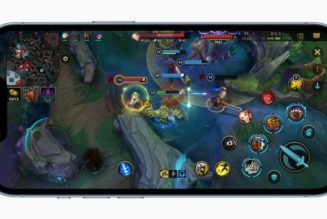When I think of a Garmin, I usually picture a behemoth of a watch worn by a sweaty marathoner — and I see plenty of both at my run club every week. What I don’t think of is lifestyle smartwatches, even though I know Garmin makes several. (Many of which I’ve reviewed!) It just wasn’t a category that played to the company’s strengths. Or at least that’s what I used to think. After testing the $249.99 Venu Sq 2, my stance is beginning to change.
As the name implies, the Venu Sq 2 is the sequel to the Venu Sq (officially pronounced S Q) and serves as the entry-level watch in Garmin’s Venu line. The Venu watches are the closest thing the company has to more traditional smartwatches, characterized by color OLED displays, sleeker designs, streamlined fitness tracking, and a slightly bigger focus on smart features. The only problem was they were kind of expensive compared to the competition. But with the Venu Sq 2, it feels like Garmin’s struck a better balance. Not only is it better than Fitbit’s Versa 4 and Sense 2, but it’s one of the best fitness watches you can buy for under $300.
a]:shadow-highlight-franklin”>How we rate and review products
a:hover]:shadow-highlight-franklin [&>a]:shadow-underline-black dark:[&>a:hover]:shadow-highlight-franklin dark:[&>a]:shadow-underline-white md:text-30″>Looks like an Apple Watch, lasts like a Garmin
I didn’t expect much when I unboxed the Venu Sq 2. What can I say? It looks like an Apple Watch knockoff, and there’s no shortage of those. Throw a stone on Amazon, and you’ll hit a couple dozen of them. My review unit also happens to be the same color as my Apple Watch Series 8. I’ve even reached for the wrong watch once or twice. Visually, the only unique things about the Venu Sq 2 are the teeny dots surrounding its 1.4-inch OLED display and the two buttons on the side of the watch.
The design did grow on me after a few days. Although the case itself is plastic, the aluminum bezel gives it a chic vibe. I wouldn’t feel underdressed with the default silicone strap, but if it’s not to your taste, you can always swap it with any standard 20mm band. Size-wise, the 40mm watch case is just right for my wrist, and it was comfortable enough to wear 24/7. At 38g, it’s lightweight, and I’m pleased to report I didn’t rip it off at night as I sometimes do with bulkier watches, and it didn’t drag down my wrist while running. That’s great if, like me, you have more petite wrists. The watch is also a slim 11mm and never caught on my winter coat sleeves.
:format(webp)/cdn.vox-cdn.com/uploads/chorus_asset/file/24259074/226428_Garmin_Venu_Sq_2_AKrales_0178.jpg)
:format(webp)/cdn.vox-cdn.com/uploads/chorus_asset/file/24259070/226428_Garmin_Venu_Sq_2_AKrales_0133.jpg)
While I prefer smaller watches for comfort, I often find their screens harder to read. But I didn’t mind the Venu Sq 2’s display. My eyesight isn’t great, but the vivid colors and larger default text size made notifications easier to read than on other similarly sized watches. The touchscreen is sometimes a half-second late when swiping, but not to the point where it’s frustrating or unusable.
While it looks like an Apple Watch, the battery life is all Garmin. With regular usage, the Venu Sq 2 has an estimated 11 days of battery life and between 20–26 hours of GPS workouts. I’ve been wearing this for about eight or nine days straight, and it’s only now starting to dip under the 25 percent mark. That’s with the always-on display disabled. Enabling it will shrink that down to about three days, though battery life will always depend on your individual usage. Regardless, you should get multiple days on a single charge, no matter your settings.
What I don’t love is the proprietary charger. It also doesn’t help that it’s still USB-A. Still, proprietary smartwatch chargers are an industry-wide problem, and at least this one works with several other Garmin watches.
:format(webp)/cdn.vox-cdn.com/uploads/chorus_asset/file/24259072/226428_Garmin_Venu_Sq_2_AKrales_0152.jpg)
a:hover]:shadow-highlight-franklin [&>a]:shadow-underline-black dark:[&>a:hover]:shadow-highlight-franklin dark:[&>a]:shadow-underline-white md:text-30″>Specs and features for days
Casual, entry-level smartwatches like the Venu Sq 2 will never outperform top-of-the-line flagships on features or durability. Even so, Garmin packs a lot into this lil guy. I’m not trying to get carpal tunnel, so here are the specs and features you need to know. (You can check out the full list here.)
- Built-in GPS (GPS, GLONASS, and Galileo)
- Smart features include alarms, timers, stopwatches, timers, a third-party app store via Garmin Connect IQ, push notifications, calendar events, media controls, find my phone / watch, contactless payments, quick replies to texts (Android only)
- Lots of watchfaces
- Sensors: Optical heart rate sensor, compass, accelerometer, SpO2 sensors
- Has emergency safety features and fall detection but requires your smartphone to work
- Supports Bluetooth and ANT Plus accessories
- 5ATM of water resistance, i.e., safe for pools
- If you get the Music version, you get about 500 songs worth of onboard storage
This is an impressive feature set for the price. And if you spend the extra $50 for the Music version, you can leave your phone at home for shorter workouts or errands. But unless you must have onboard music, I’d recommend sticking with the regular model since this isn’t a true standalone watch — you’ll usually have your phone with you.
:format(webp)/cdn.vox-cdn.com/uploads/chorus_asset/file/24277225/Screen_Shot_2022_12_05_at_4.33.56_PM.png)
If you do get the Music version, offline Spotify playlists are the easiest way to listen to music. You can download them right from the watch app. (You’ll need a Premium account.) It took about five minutes to transfer the 100 songs in Spotify’s This is: EXO playlist. I’m listening to it as I write this review and having a grand time. The Connect IQ store also supports Amazon Music, Deezer, and a handful of others. Apple Music users can also transfer playlists via the Garmin Express desktop app, but it’s a hassle because it only transfers files that you’ve bought from the iTunes store, not ones you stream through Apple Music’s subscription service. This mangled my sacred running playlist and wasted an hour of my life. Trust me: just use Spotify, or stream from your phone.
The Venu Sq 2 supports contactless payment via Garmin Pay. It isn’t as widespread as Apple Pay or Google Wallet, but it’ll do in a pinch. I had no difficulty adding a card and paying for a drink from the vending machine. You’ll want to double-check the list of banks that support Garmin Pay, but there’s a ton in the US. In certain cities, you can also use it for public transit, though in the US, that only includes New York, Chicago, and Portland, Oregon.
However, the Venu Sq 2 isn’t a truly standalone watch because Garmin’s safety and fall detection features require your phone’s cellular connection. It’s fine when sticking close to home. I’ve left my phone behind for a short recovery run around the block and while cross-training at my building’s gym. The key is that in either scenario, I’d be able to get help even without my phone. I’d be much warier of leaving my phone at home when venturing outside my neighborhood.
a:hover]:shadow-highlight-franklin [&>a]:shadow-underline-black dark:[&>a:hover]:shadow-highlight-franklin dark:[&>a]:shadow-underline-white md:text-30″>Excellent fitness and health tracking
I tested the Venu Sq 2 on several GPS runs alongside my phone, the Apple Watch Ultra, and the Series 8. The differences were so negligible it almost wasn’t worth recording. The Ultra’s multiband GPS was better, but not by a whole lot. In heart rate testing, the Venu Sq 2 was on par with my Polar H10 chest strap and the Ultra. These results are a snoozefest, but that’s a good thing. This is a Garmin watch, and it performs like one.
The Venu Sq 2 doesn’t track every possible metric, but it doesn’t need to. Even experienced athletes may not use everything Garmin tracks on its more expensive watches. What matters is you’ve got all the basics like steps, calories burned, and intensity minutes. I’m a fan of the latter, as it helps beginners understand whether they’re getting the recommended 150 minutes of moderate exercise per week. The watch can also track most common activities, including pilates, yoga, HIIT, and sessions on gym equipment like ellipticals. You’ll be covered unless you’re into the most extreme of sports.
This is a Garmin watch, and it performs like one
On the wellness front, you get features like sleep tracking, stress tracking, period tracking, hydration tracking, guided breathing sessions, respiration rate, and Garmin’s Body Battery recovery gauge. Of these, Body Battery is the most unique. It’s a gauge of how much energy you’ve exerted in a day versus how much you’ve recharged the previous night. I’ve used it a ton over the years, and it’s generally spot on. For beginners, it’s a good, simple way to visualize recovery.
:format(webp)/cdn.vox-cdn.com/uploads/chorus_asset/file/24259062/226428_Garmin_Venu_Sq_2_AKrales_0020.jpg)
:format(webp)/cdn.vox-cdn.com/uploads/chorus_asset/file/24259066/226428_Garmin_Venu_Sq_2_AKrales_0091.jpg)
This isn’t really the Garmin for advanced athletes, but what I like about the Venu Sq 2 is it’s a watch you can grow with. It’s simple enough for beginners, but there’s stuff for intermediate-level athletes, too — especially runners. The Garmin Coach training plans for 5K, 10K, and half-marathons are more in-depth than the general fitness classes or programs you’ll find in Apple Fitness Plus and Fitbit Premium. I like it more than some plans I’ve tried on dedicated running apps like Runkeeper, too. Garmin’s plans are led by professional coaches with different teaching styles and take into account your current fitness level and history. The program adapts as you go along, and the workouts are automatically synced onto your wrist.
Plus, all this content is free. That’s so rare in fitness tech; most apps and services lock the good stuff behind paywalls. Of course, it might change down the line, but for now, Garmin’s made it clear it has no intention to do so.
a:hover]:shadow-highlight-franklin [&>a]:shadow-underline-black dark:[&>a:hover]:shadow-highlight-franklin dark:[&>a]:shadow-underline-white md:text-30″>A confusing, cluttered app
The Garmin Connect smartphone app has improved over the years, but the user interface still isn’t friendly to newcomers. Commonly used settings are often buried in places you wouldn’t think to look, and reviewing data often feels like staring at a wall of text and numbers. Just look at this gallery of the daily dashboard and a typical running workout summary. This is just a taste. I’d need more than seven screenshots to capture everything tracked on a low-key day. Other apps rarely require more than two or three.
1/4
I’m a data maximalist, so this cursed data wall is partly my own making. (Shoot these stats straight into my eyeballs, baby.) Minimalists need not suffer as I do. You can edit the dash to be less cluttered. I keep everything visible because I’m afraid of losing certain metrics in a maze of Garmin menus. The thing is, so many fitness and training apps present the same exact data in a more digestible way. Hell, I often prefer viewing my Garmin data through Strava.
Shoot these stats straight into my eyeballs, baby
Changing on-wrist and app settings can also be a pain. For instance, if you want to turn on the always-on display, you have to long-press the bottom button before following Settings > System > Display > Not during activity / During Activity > Timeout > Always-On. There’s no quick settings menu like on most other smartwatches. Another weird thing is you can’t manage Venu Sq 2 watch faces from the app, just on the watch itself. You run into a lot of this, as evidenced by the numerous Garmin Connect FAQs online.
One thing I do like about the Connect app is it’s highly customizable. For instance, you can edit the tabs at the bottom of the Connect app and program hotkeys or shortcuts. It’s a steep learning curve, but if you put the effort in, you can make things as complex or simple as you like. It’s not so bad once you get used to it. (Either that or I have Stockholm Syndrome.)
a:hover]:shadow-highlight-franklin [&>a]:shadow-underline-black dark:[&>a:hover]:shadow-highlight-franklin dark:[&>a]:shadow-underline-white md:text-30″>Garmin vs. Fitbit
If you’re considering the Venu Sq 2, you might be coming from Fitbit. After all, for this price, you can get a smarter smartwatch in the form of an Apple Watch SE or a midrange Wear OS watch. The Venu Sq 2 is for people who care more about long battery, affordability, and in-depth health tracking. This is Fitbit’s historic niche, but the company’s lost a lot of ground in recent years. Garmin is one of the few names out there offering devices that can work as a 1:1 replacement. (I suggest also checking out brands like Amazfit, as they’re a great value — but I get wanting to stick with a more familiar brand.)
Garmin and Fitbit have different approaches to health and fitness, but their devices check many of the same boxes. Both companies are known for wearables with long battery life that work with both iOS and Android. They each have their own contactless payment systems and third-party app stores. So why should you get a Venu Sq 2 over a Versa 4 or a Sense 2?
:format(webp)/cdn.vox-cdn.com/uploads/chorus_asset/file/24259075/226428_Garmin_Venu_Sq_2_AKrales_0199.jpg)
If you’re going to spend between $200–$300 for this type of smartwatch, you want an ecosystem that gives you room to grow. It ought to get better with each generation, and you ought to have options if your goals change. As I wrote earlier, the Venu Sq 2 is a smartwatch that can level up with you. This is an entry-level Garmin. Once you feel ready to take on more adventurous activities — marathons, ultramarathons, off-grid hikes, triathlons, etc. — you can graduate to Garmin’s more advanced lines like the Forerunner, Fenix, or Epix (and all the navigational features and extra metrics they track). Or, if you simply want a better, rounder version of the Venu Sq 2, there’s always the Venu 2 Plus.
Conversely, the Versa 4 and the Sense 2 are the best Fitbit has. They have fewer features than their predecessors, and I’m not convinced we’ll ever see a Versa 5 or Sense 3. If you want to upgrade, you’ve pretty much got the Pixel Watch and only the Pixel Watch. At this point, I’d only recommend the Versa 4 or Sense 2 if features like EKG or a simpler app are a priority.
The Venu Sq 2 isn’t perfect, but Garmin continues to improve its casual trackers. At the end of the day, I like where Garmin is headed. Fitbit? I’m not so sure.
Photography by Amelia Holowaty Krales / The Verge
a:hover]:shadow-highlight-franklin [&>a]:shadow-underline-black dark:[&>a:hover]:shadow-highlight-franklin dark:[&>a]:shadow-underline-white md:text-40 lg:-ml-100″>Agree to continue: Garmin Venu Sq 2
Every smart device now requires you to agree to a series of terms and conditions before you can use it — contracts that no one actually reads. It’s impossible for us to read and analyze every single one of these agreements. But we’re going to start counting exactly how many times you have to hit “agree” to use devices when we review them since these are agreements most people don’t read and definitely can’t negotiate.
To use the Garmin Venu Sq 2 or Venu Sq 2 Music, you must pair it with an iPhone or Android smartphone. That includes the phone’s Terms of Service, privacy policy, and any other permissions you grant. You must also create a Garmin Connect account to use the app.
By setting up the Garmin Venu Sq 2, you’re agreeing to:
All of Garmin’s privacy and legal policies are available within the Garmin Connect app. You must also grant the Garmin Connect app certain phone permissions for Bluetooth, calendar, location, and notifications. Additionally, optional safety features, like LiveTrack, also come with an end-user license agreement. You may also have to agree to share your health data with the company for certain features. If you decide to enable Garmin Pay, you’ll also have to agree to the Garmin Pay Terms and Conditions and Garmin Pay Privacy Policy. Integrating your Garmin activity data with other services, like Strava, Spotify, or Apple Health Kit, also requires you to agree to those individual terms and policies.
Final Tally: Whatever your phone requires, plus three mandatory Garmin policies and four phone permissions for smart features. There are additional policies for optional health insights, contactless payments, and safety features.








